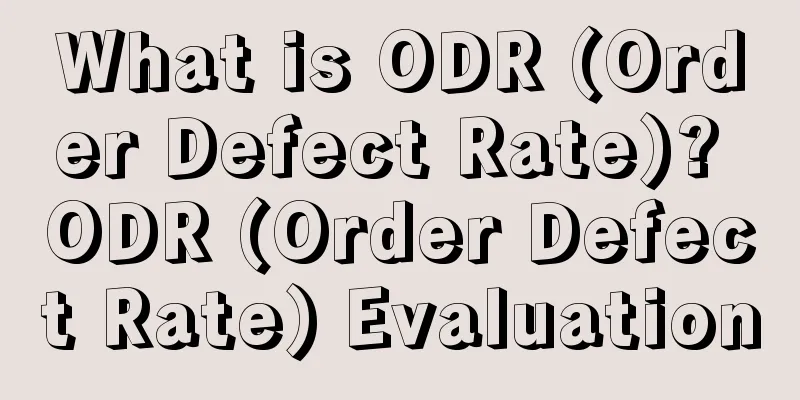What is ODR (Order Defect Rate)? ODR (Order Defect Rate) Evaluation

|
The Order Defect Rate (ODR) is the primary metric for measuring your ability to provide a good buyer experience. It covers all orders with one or more defects as a percentage of the total number of orders within a given 60-day period. An order is defective if it has negative feedback, an A-to-z Guarantee claim (not declined), or a credit card chargeback. The policy states that sellers should maintain an ODR below 1% to be able to sell on Amazon. An ODR above 1% may result in account deactivation. ODR has three components 1. Negative feedback rate The negative feedback rate (expressed as a percentage) is the number of orders that received negative feedback during the relevant time period divided by the total number of orders during that time period. This metric is tied to orders, which means that when calculating the negative feedback rate, we consider the order date, not the date the feedback was received. The negative feedback rate is different from the feedback that buyers see, which is calculated based on when the feedback was received, not when the order was placed. Sellers' commitment to maintaining a low negative feedback rate reflects our customer-centric philosophy. One- and two-star ratings are considered negative feedback. For more information, see Monitoring Your Account Health. Note: If a buyer removes negative feedback, we do not consider this feedback when calculating ODR. However, it may take 48 hours for the feedback to disappear from the metrics after the buyer removes it. 2. Amazon Marketplace Transaction Guarantee Claim Rate The A-to-z Guarantee Claim Rate (expressed as a percentage) is calculated by dividing the number of orders that received an A-to-z Guarantee claim during the relevant time period by the total number of orders during that time period. The following types of claims can impact your order defect rate: Claims that have been approved and debited from your account (shown as "Claim approved, funds provided by seller") You provided a claim for order refund after the buyer filed a claim (displayed as "Order Refunded") Claims resulting from order cancellation by you or Amazon (shown as “Order Cancelled”) Claims that are under review (displayed as "Under Review"). The following types of claims do not impact your order defect rate: Claims that have been approved and paid by Amazon (shown as “Claim approved, funds provided by seller”) Claims we rejected (shown as "Completed") Claims withdrawn by the buyer Claims where the order was shipped through Amazon Buy Shipping Service and the reason was "Item Not Received" Sellers who proactively reach out to buyers to resolve order issues will avoid most A-to-z Guarantee claims. 3. Credit card rejection rate The chargeback rate, expressed as a percentage, is the number of orders that received a chargeback during the relevant time period divided by the total number of orders during that time period. This metric is tied to orders, which means that when calculating the service chargeback rate, we consider the order date instead of the date the service chargeback was received. A credit card chargeback is similar to an A-to-z Guarantee claim, except that the claim processing and decision is made by the credit card issuer, not Amazon. Possible problems include: The buyer claims that he did not receive the product. The buyer returned the item but did not receive a refund. The buyer received a damaged or defective item. When a buyer disputes a purchase that was charged to their credit card, Amazon calls this a chargeback. We broadly categorize chargebacks into two categories: fraud chargebacks and service chargebacks. A fraudulent chargeback means that the buyer claims that they did not purchase an item. This type of claim is often associated with a fraudulent buyer using a stolen credit card. Amazon does not consider chargebacks for fraudulent transactions when calculating your Order Defect Rate. A service chargeback occurs when a buyer confirms that they purchased the item but indicates to the credit card issuer that they experienced a problem. *Note: For more information about communicating with buyers, see Communicating with Buyers Using the Buyer-Seller Messaging Service. View ODR and download ODR report process Go to the Account Status page. In the Buy Customer Service Performance section, click View Details. Select the Order Defect Rate tab. Scroll down and click the Download Report button. |
<<: What is Ever Marker? Ever Marker Review
>>: What is ESTONE? ESTONE Review
Recommend
What is MaxAB? MaxAB Review
MaxAB is a Cairo-based B2B e-commerce marketplace ...
What is Jetblack? Jetblack Review
Walmart's tech incubator Store No. 8 has launc...
What is Tmall Global? Tmall Global Review
Tmall Global is an import retail platform under Al...
Walmart and US publishing giant Meredith Corp teamed up to create purchasable "cookbooks"!
It is learned that Walmart recently announced a pa...
Is the epidemic bonus fading? FedEx's transportation volume has dropped the most! Amazon's transportation growth has stopped!
New U.S. package delivery data from Pitney Bowes o...
Amazon Advertising - Top Questions and Answers 101
Today I’m sharing with you a collection of popular...
Online return costs in the U.S. rise 7% during peak season! Sellers choose to refund rather than return goods
It is learned that against the backdrop of rising ...
Amazing! Amazon has made new moves, and sellers have new black technology!
It has been more than a week since Prime Day ended...
What is Sezzle? Sezzle Review
Sezzle is a payment solution that breaks purchases...
What is HipVan? HipVan Review
HipVan is a website that sells mainly designs, inc...
Will Amazon's self-operated business be hit hard? Antitrust bill may be introduced, sellers have an opportunity!
It’s less than a week away from the Spring Festiva...
After the peak season, a group of sellers were laid off and went home early for the New Year.
New Year’s Day is over, is the Spring Festival far...
How to get top rankings on Amazon ads
Amazon's A10 search engine algorithm is respo...
What is Feedbackwhiz? Feedbackwhiz Review
Feedbackwhiz is an Amazon erp software that can bo...
What is Jiamofang? Jiamofang Review
Hangzhou Jiamofang Technology Co., Ltd. is a start...









